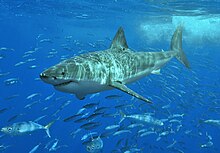


There are a range of shark attack prevention techniques employed to reduce the risk of shark attack and keep people safe. They include removing sharks by various fishing methods, separating people and sharks, as well as observation, education and various technology-based solutions.[2]
Techniques that involve culling sharks are contentious. Environmental groups have voiced concern over the impact of reduced shark numbers on ocean ecosystems and the problem of by-catch of other marine life, particularly endangered species.[3][4] Because sharks are important to the ecosystem, removing them harms the ecosystem.[5]
- ^ a b c "ISAF Statistics on Attacking Species of Shark". Global Shark Attack File. 9 May 2020. Retrieved 9 May 2020.
- ^ Cite error: The named reference
Optionswas invoked but never defined (see the help page). - ^ Cite error: The named reference
Meyerwas invoked but never defined (see the help page). - ^ Cite error: The named reference
Schetzerwas invoked but never defined (see the help page). - ^ https://eu.oceana.org/en/importance-sharks Eu.oceana.org. The Importance of Sharks in the Ecosystem. Retrieved September 20, 2018.